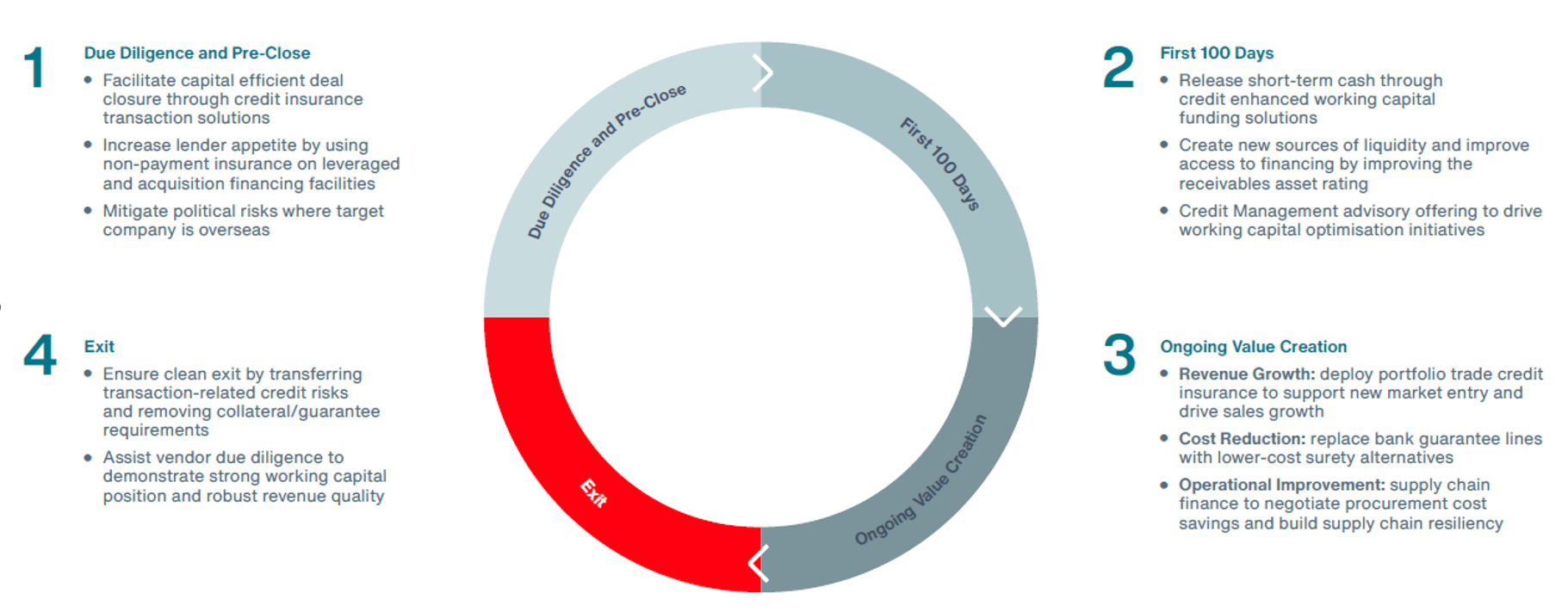The current macroeconomic challenges has led many to forecast a prolonged slowdown in private equity deal volumes and question whether the return levels of previous years can be sustained. Despite these
challenges, it is an opportune time for private equity firms to deepen their focus on value creation through
operational improvement and reduce emphasis on financial engineering to generate value.
A key pillar of an operational improvement strategy is working capital optimization which can create liquidity and
release short-term cash, as well as enable access to off-balance sheet financing and support de-levering.
The benefits of a sound working capital strategy are well documented. One of the most regularly cited studies on
working capital and firm performance concludes that ‘firms that converge to an optimal level of working capital
improve their stock performance and operating performance’1.
A lesser emphasized finding of the study is that freed up working capital was most often redeployed to fund
investment in revenue growth.
In other words, besides the liquidity and financing benefits, working capital optimization initiatives often have
second-order effects such as boosting sales growth, which can support the private equity firm’s value creation
objectives.
In fact, the strategic use of credit insurance solutions should be incorporated into the value creation playbook not
only to capture upfront liquidity advantages, but also for additional benefits that can actively support value
generation such as market expansion, procurement efficiency, and debt reduction.
Whilst credit solutions can meet a range of strategic objectives across the investment life cycle (see schematic at
the end of the article), the post-acquisition role of credit solutions to drive private equity value creation
through working capital initiatives is the focus of this article.
The strategic use of credit solutions (credit insurance, political risk insurance and surety) can enhance liquidity,
improve transaction returns, facilitate capital-efficient deal closures, and support long-term value creation.
Corporate Treasury
1. Raise Off Balance Sheet Financing
During the first 100 days, a common workstream for the treasury function is to review, consolidate and optimize
existing sources of working capital bank lines. It can also be an opportunity to explore off-balance sheet financing
structures (subject to local accounting treatment) that can improve debt metrics, create financial flexibility and
prevent potential covenant breaches, while still maintaining access to the same level of financing lines.
The use of portfolio trade credit insurance to enable off-balance financing is a commonly used strategy by
sophisticated corporates and one that can be replicated by portfolio companies of all sizes. For relevant
industries, operating leases can be considered as they qualify for off-balance sheet treatment in certain
jurisdictions, and credit solutions can play a key role in credit-enhancing such leasing structures.
2. Leverage the Trade Finance Market
Portfolio companies can turbocharge growth through trade financing solutions that are designed to support sales and
revenue momentum. By looking beyond vanilla receivables financing, companies can evaluate the relevance of
distributor finance or warehouse/ inventory finance and understand whether it can support their business models and
deliver growth. Some of these solutions can also enhance the inventory component of the cash conversion cycle which
is often overlooked.
Credit insurers have deep experience with a variety of trade financing structures and can partner with lenders
resulting in cost competitive and bespoke trade financing solutions.
3. Create New Source of Funding
During the initial post-close period when there may be greater liquidity pressures, portfolio companies with
medium-tenor receivables (two to five years) can benefit from a large upfront injection of liquidity by financing
those receivables and deploying the cash to fund other value creation projects. Structured credit insurance can play
an important role here as it often increases lender risk appetite for medium tenor receivables financings and
potentially lowers overall costs.
An incremental benefit is that it also sets up a self-funding mechanism to support other value creation initiatives.
4. Preserve Existing Sources of Funding
In some sectors, the use of bank guarantees is required in the normal course of business, and this can take up a
significant portion of financing capacity and collateral.
Surety solutions are a meaningful alternative provider of guarantees with the differentiating benefit that they do
not require collateral and are competitively priced. In addition, they do not take up bank financing lines, and
preserve a valuable source of funding.
Sales Management and Strategy
1. Valuable Sales Tool to Drive Growth
In a competitive B2B market, sales teams with the option to offer deferred payment terms can gain a critical edge in
winning new business and securing existing client relationships. With a funded credit solutions program, portfolio
companies can avoid the adverse cash flow impact of deferring their receivables and accelerate their cash conversion
cycle by monetizing those receivables.
More importantly, it equips the front-line sales force with a valuable tool to help meet aggressive revenue targets
without sacrificing working capital.
2. Support Market Expansion
Entry into new geographies or new customer segments is often a strategic priority for portfolio companies in the
value creation journey. The tactical use of credit risk insurance can de-risk market entry by giving confidence to
transact with new customers that may be further down the credit spectrum, or ones that are based in new countries.
Conversely, concentration risk on large existing customers can be managed by insuring their receivables to safeguard
revenue quality.
3. Access to Credit Risk Data and Analytics
Partnering with credit insurers can allow firms to leverage a deep global pool of credit risk data and analytics.
Credit quality ratings on customers can provide valuable insights and be a useful tool in business planning
processes.
In fact, credit insurance coverage coupled with advice from insurers can be a critical resource of data for credit
control teams and provide decision-making support in managing the receivables book and payment terms. For smaller
portfolio companies, it may even allow for a leaner credit control function and deliver longer-term costs savings.
Procurement and Supply Chain
1. Build Supply Chain Resilience
As many firms continue to reconfigure supply chains, the use of supply chain finance and similar payables financing
solutions is an opportunity to develop resilience in the supply chain by providing suppliers a valuable source of
liquidity. Credit solutions can enable supply chain finance and potentially lower the financing charges that lenders
require to offer these programs.
The implementation of these structures often provides an opening for the Procurement function to extend or harmonize
payment terms which delivers a working capital boost. It can also lead in a broader review or negotiation of
supplier contracts which can create procurement efficiencies for the portfolio company.
2. Leverage the Credit Value Chain
Portfolio companies without a sufficiently high credit rating to anchor their own supplier financing programs can
explore opportunities within their credit value chain.
Firms can partner with their credit solutions advisor to directly engage the insurance market and build new credit
insurance capacity on their own credit risk. New insurance capacity created through a ‘reverse credit’ exercise can
be introduced to key suppliers and potentially enhance future commercial negotiations. This is especially powerful
for companies that have recently entered private ownership (i.e. through a private equity purchase) or those that
can credibly demonstrate a turnaround story and highlight financial and operational improvements recently achieved.
Companies should also investigate upstream opportunities on the credit value chain such as whether their larger
customers have existing payables finance programs and attempt to get onboarded.
Across the various functions of the portfolio company, whether it is corporate treasury, sales, or procurement,
credit solutions can be a meaningful tool to optimize working capital and support broader initiatives to deliver
sustainable revenue growth and create new operational efficiencies.
With the increased use of credit insurance capital by private equity firms, the use of credit solutions is
increasingly an integral part of value creation plans and a critical working capital optimization tool for portfolio
companies.
Driving value across the private equity investment lifecycle
Credit solutions can meet a range of strategic objectives across private equity investment lifecycle.
1 Aktas, Nihat and
Croci, Ettore and Petmezas, Dimitris, “Is Working Capital Management Value-Enhancing? Evidence from Firm
Performance and Investments.” Journal of
Corporate Finance, 2015.





























































































































































































































































































































































